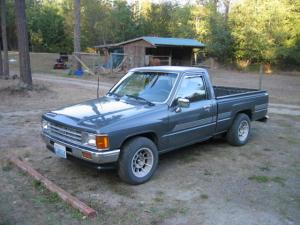| Owner | George Mifsud (former owner, EV has been sold) |
|---|---|
| Location | Port Townsend, Washington United States map |
| | |
| Vehicle | 1987 Toyota Pickup short-bed pickup |
| Motor | Netgain WarP9 Series Wound DC |
| Drivetrain | 5 speed manual, rear-wheel drive |
| Controller | Curtis 1231C-8601 |
| Batteries | 20 US Battery US 125, 6.00 Volt, Lead-Acid, Flooded |
| System Voltage | 120 Volts |
| Charger | Zivan NG3 |
| Heater | replaced original heater core with ceramic heating element from a floor heater. Will relate heater temperature control on dash to how much current is sent. Will have a temperature reader near the heating element as well as a fuse as a safety feature. |
| DC/DC Converter | Iota DLS 55 |
| Instrumentation | Custom, not quite done but will have a digital display showing voltage and a scale showing how much 'gas' is left, on one row. The second display row will show current and a scale showing the user how many amps they're sucking relative to the 'max'. |
| Top Speed | 60 MPH (96 KPH) |
| Acceleration | 0 to 40 in 14 seconds |
| Range | 50 Miles (80 Kilometers) Put it through the paces. 20 miles at 50mph and the rest driving around rural and somewhat hilly Port Townsend. |
| Seating Capacity | 3 adults - bench seat |
| Tires | came with the car - nothing special. |
| Conversion Time | Entire process took 8 months, but the bulk of the work was done in 3 months. |
| Conversion Cost | $12,500 and still no paint job |
| Additional Features | Since we wanted the bed to be usable, we decided to hinge the bed to the side. The bed sits on large rubber stoppers and the non- hinged side has a latch that pulls the bed tight. We made custom hinges because the hinge point needed to be very low. We have a steel arm that drags along a trough and locks into position when the bed is in optimum position. I am also proud of the simplicity and economy of my battery boxes. The walls are coroplast, or plastic cardboard. It's very cheap by the 4 x 8 sheet and is really sturdy. I used 6mm and simply cut and dropped them into the angle-iron frames. Some of my boxes were too tight and I had to glue them to the outside of the frames with adhesive. The charger is mounted on the back wall of the cabin, behind the bench seat. This has the added advantage of warming things up a bit for those chilly mornings. I enclosed the controller and have a small computer fan sucking air past it. I was getting a consistent squeal on warm days, due to the controller having issues getting the correct juice to the motor, which wailed in anguish. I added a reservoir and small 12v pump for the windshield washer because the original was in the way of the front battery pack. Did the usual vacuum pump/switch/reservoir thing for the brake assists. |
| My friend Robert and I learned much from this experience. The 'next times' include: 1. Changing the battery configuration in the two battery boxes behind the cabin. We discovered that the space between the drive shaft and frame were not equal. We ended up re-routing the rear brake line and emergency brake cable. 2. We probably don't really need a ginormous fuse. We already have a breaker behind the driver's side of the seat. 3. Have a clean and warm environment to work in. Have space and a nice welding table. 4. Gather all your tools and components and then 'just do it!' | |
Copyright © 1997-2025 by Mike Chancey









